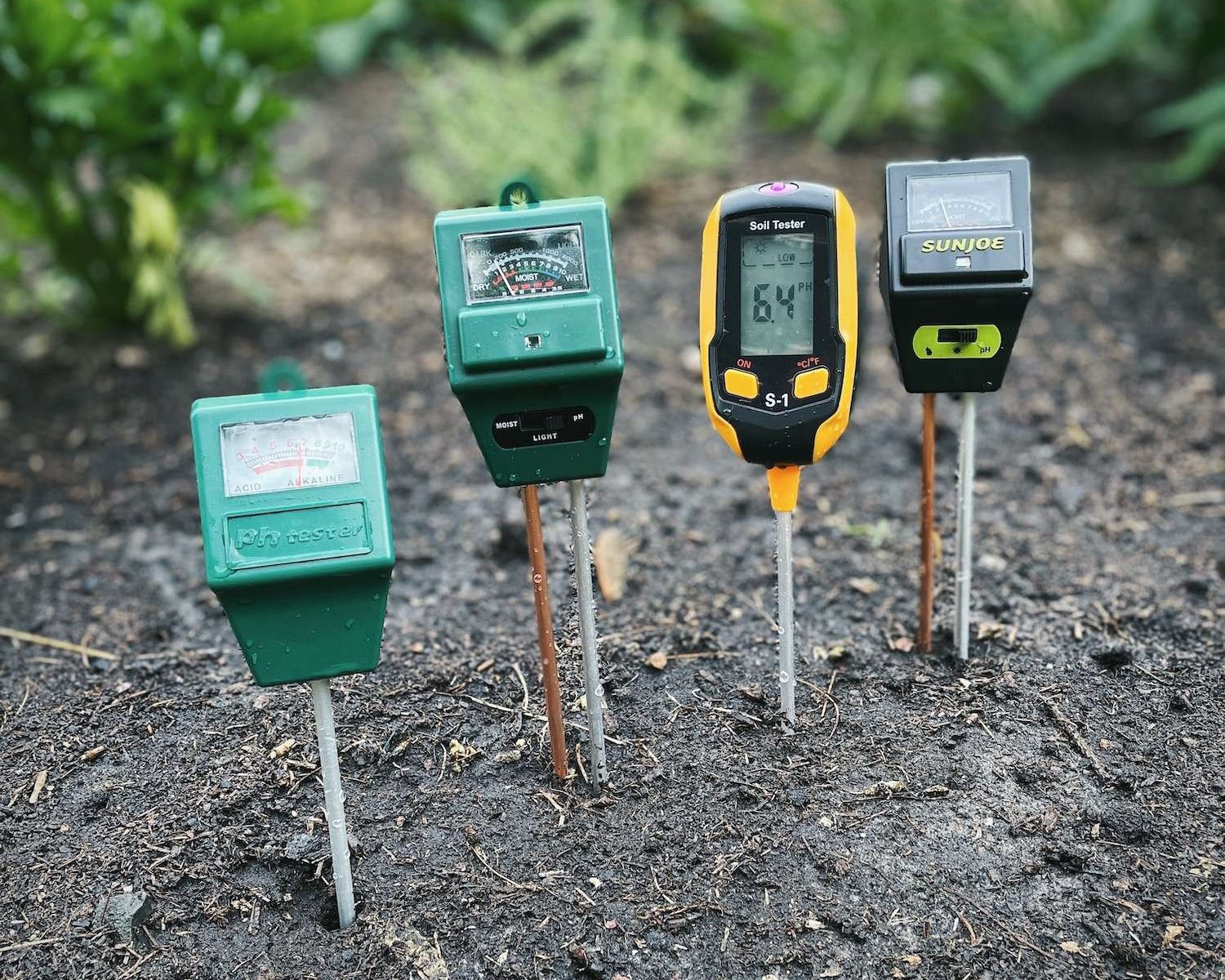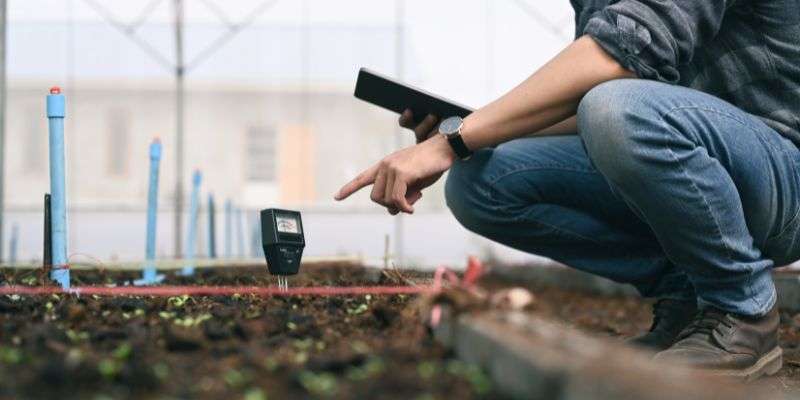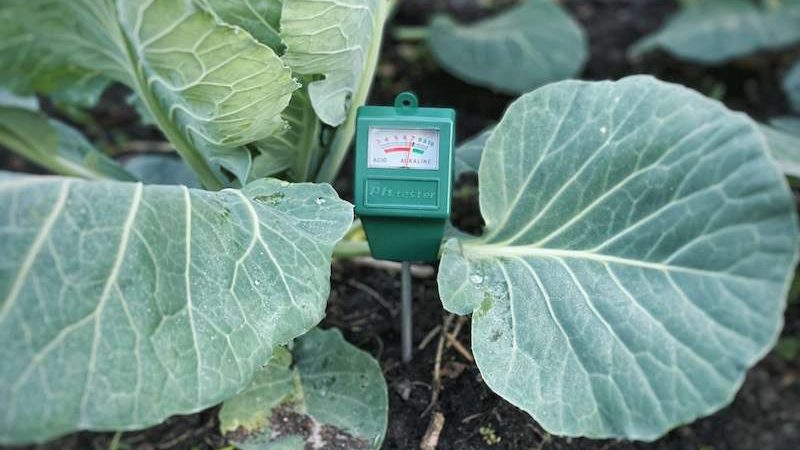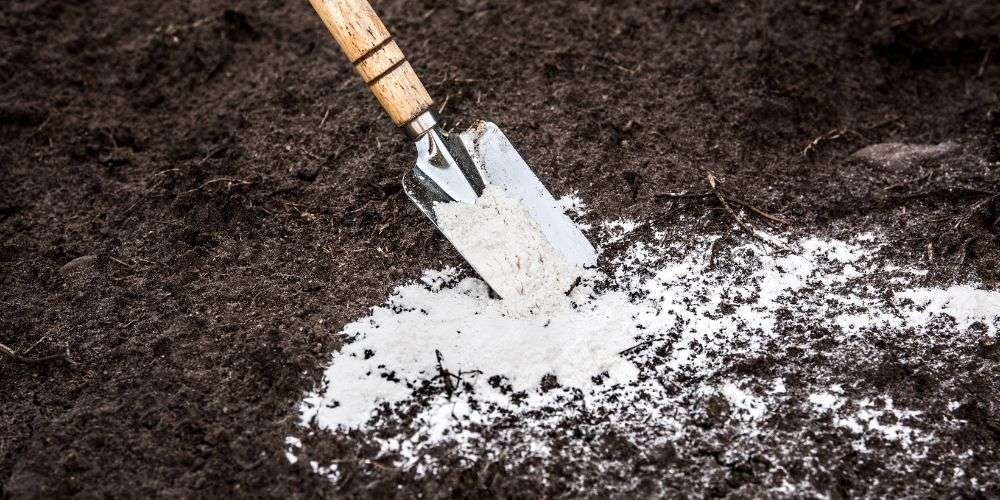If your garden plants are stunted and not growing well, then acquiring the best soil pH tester on the market is a great first step to diagnosing the issue! Many people forget about testing the pH of their garden soil, so make sure that you aren’t making this common mistake.
Soil pH testers provide valuable information, are inexpensive, and can be used year after year (if cared for properly – more on this later!). Plus, they are super easy to use and it’s kind of fun to feel like a scientist in your garden.
In this article, we’ll break down the best soil pH testers on the market, the necessary features, how to use them, care for them properly, and much more!
Let’s jump in!
*Disclosure: This post may contain affiliate links to products (including Amazon). I’ll earn a small commission if you make a purchase through my link, at no additional cost to you! Regardless, I only link to products that I personally use on our homestead or believe in.
What is Soil pH?
Soil pH is a measure of how acidic or alkaline your garden soil is. Each plant has its preferred pH range, but a general rule of thumb for an ideal pH range for most garden plants is 6.0-7.0.
The pH scale is a broad spectrum that ranges from 1-14, with each number being 10x higher or lower than the previous. For example, a pH of 5 is 10x more acidic than a pH of 6.
- pH of 1: very acidic
- pH of 4: acidic
- pH of 7: neutral
- pH of 10: alkaline
- pH of 14: very alkaline
Why Use a Soil pH Tester?
Ensuring that the pH of your garden soil is within the ideal range of your plants is important for proper growth and fruit development. Each plant has its preferred soil pH and will suffer if the soil is outside of this range. Even if you’re growing containers or grow bags, it’s important to keep an eye on it!
Issues with acidic soil
When garden soil is too acidic, nutrients and micronutrients are less bioavailable, which ultimately leads to deficiencies. Aluminum becomes soluble and can be taken up by plants resulting in aluminum toxicity and stunted growth. Acidic soil also disturbs the activity of healthy microorganisms in the soil.
*Common causes of acidic soil are excessive rainfall, organic matter decay, or acidic parent material (ex: pine needles).
Issues with alkaline soil
When garden soil is too alkaline, this can cause reduced availability of nutrients and micronutrients, ultimately resulting in deficiencies and stunted growth.
Common causes of alkaline soil are watering with hard water that is rich in lime or growing in a desert or dense forest location.
Features of the Best Soil pH Testers
There are many different types of soil pH testers on the market. Some are good, but some are bad! Here’s what you should be looking for when deciding which soil pH tester is the best for you and your garden.
Chemical vs Electronic
There are two different types of soil pH testers: chemical and electronic. Both are fairly equivalent in terms of accuracy if used correctly, however, there is a clear winner here in my opinion:
- Chemical soil pH tester: Utilizes test tubes where the soil is mixed with distilled water plus a chemical that changes the color of the solution. Then, the solution is compared to a chart. This makes it a one-time-use product and is time-intensive.
- Electronic soil pH tester: Utilizes a probe that is inserted directly into moistened garden soil to provide an immediate reading through an embedded electrode that measures the charge of the soil compared to a reference solution. This allows for repeated testing throughout different garden beds in an efficient manner. This is a sustainable option and a clear winner in my book!
Probe-Length
Look for electronic soil pH testers that feature a long test probe (at least 7-8” long). The goal is to measure the pH around the roots of the plant, not the soil surface. Therefore, the longer the probe, the better – especially if you are growing plants with deep roots (tomatoes, potatoes, etc.)!
pH scale
Most soil pH testers on the market can handle a wide pH range, but it’s a good idea to verify this before you purchase. Some vegetables prefer to grow in a pH range as low as 4.5 (potatoes) or as high as 8.0 (asparagus), so make sure your meter will be able to handle that.
*Not sure what pH your vegetables need? Don’t worry, I’ve done the work for you! Check out my product recommendations table in the section below!
Functionality
Who doesn’t like a multi-functional tool? While they can be fun, I’ve found that when more features are involved, there’s more opportunity for something to break. Also, I feel like accuracy is better if the tool is focused on one task.
- If you want the most accurate tool that is durable and you don’t mind having multiple tools on hand (to measure moisture, nutrients, and pH), then a single-functionality tool would be a great choice!
- If you are on a budget, don’t mind a little variability in readings, or don’t have the space to store multiple tools, then a multi-functionality tool might be a great choice for you.
Accuracy
This is the most important feature when looking for the best soil pH tester on the market. There’s no point in using one if it’s not accurate. I’ve researched for you and have provided the best ones in the product table below!
Durability
Durability is a huge factor, especially when it comes to the delicate probe(s) on the soil pH tester. Some models are cheaply made and these can snap off, making your tool useless. I’ve kept durability in mind when deciding on the 5 best soil pH testers for you!
Digital vs Analog
Choosing between digital and analog is purely a personal preference. With digital, you will need to provide some sort of power whether that’s fresh batteries or plugging it in for a charge. However, digital does provide a more precise pH reading compared to analog. I personally like the simplicity of analog – fewer things to break or power up!
The 5 Best Soil pH Testers in 2024
Alright, friends! Here we go. I’ve scoured the internet to see what’s out there and kept all of the features above in mind to decide on the 5 best soil pH testers on the market in 2024.
The Homesteading RD's Product Picks: This pH tester is the best bang for your buck! I love that it features a single probe (less likely to break) and the display is easy to read. No batteries required, plus, it comes with a bonus moisture meter! Lightweight at only 1.6 ounces! Probe length: 7" pH Range: 3-10 This digital pH tester is the best one on the market in terms of accuracy, great display, and pH range (it'll read anywhere from 0-14!). It does come with a heavier price tag because of these features. Of note, the probe length is fairly short and does require 3 LR44 batteries to operate. Probe length: 5.5" pH Range: 0-14 This meter not only measures pH, but it also measures moisture, nutrient, and light levels. I like that it has a single probe (less likely to break), but it is fairly short at 6.6". Features a tiltable head so it's easier to read. This model has a narrower pH detection range than the ones above Probe length: 6.6" pH Range: 1-8 This soil pH tester has 40,000+ reviews on Amazon, but it does come with a catch! The double-probe feature increases the risk of one of them breaking. It also requires a full 10 minutes to register the pH reading. This model has a narrower pH detection range than the ones above, and the display is hard to read. Probe length: 7.9" pH Range: 3.5-8 While this article is mostly focused on probe-style soil pH testers, this soil test kit can be quite helpful if you are wanting to measure more than just pH. This kit comes with 40 tests and measures pH, nitrogen, phosphorus and potash. It's fairly accurate, too! Just know that this is a more time-intensive method, especially if you are wanting to test several sections of your garden at a time.
How to Use a Soil pH Tester
Now that you have the best soil pH tester on the market, it’s important that you know how to use it properly! Without proper preparation, your reading may be inaccurate. Read on to learn how to use it, care for it so it lasts for years to come, plus troubleshooting tips!
Testing
*Always follow the manufacturer’s instructions for the specific model you have selected, but these are the general steps that should apply to most models.
- Wet the soil in the testing area. If your soil pH tester comes with a moisture meter, take a reading. The soil moisture should be between 4-7 (moist, but not soaking wet). If the soil is too dry, the reading won’t take.
- Flip the switch on your tester to measure pH (if it’s a multiple-feature model)
- Gently insert the probe into the soil, near (but not directly into) the roots of your plant. If you encounter any resistance, do not force the probe in or it could break.
- Wait a minimum of 10 seconds, then note the pH reading. Read your product instructions for its required processing time (some products take up to 10 minutes!).
- Remove the probe and wipe it off with a clean cloth.
- Test again to verify your reading.
Care and Storage
Even the best soil pH testers on the market are delicate. That’s the nature of these instruments. They need to be properly cared for in order to last for years to come.
- After using, wipe off any soil or moisture with a clean cloth
- Never insert the probe into a glass of water or any other liquid. This can damage the probe.
- Never leave the probe in the soil for prolonged periods. This can result in corrosion. Always remove promptly after testing.
Troubleshooting
Having trouble with your soil pH tester? Here are some of the most common issues you’ll encounter:
The soil pH reading did not move
- Your soil may be too dry. Try adding a little moisture and re-test.
- You may be testing too deep (where the soil is drier), water more deeply or position your meter a couple of inches higher and try again.
- It’s very possible that your soil pH is 7.0, which is what most soil pH meters hold at when not inserted into the soil.
My soil pH probe has black spots on it
- The copper on the probe will naturally oxidize from exposure to air over time. This is normal and can be remedied with a gentle cleaning or by using it frequently. By inserting it into the soil, these black spots will rub right off.
The soil pH probe snapped off
- Once the probe has detached, there is no fixing it. Thankfully, these tools are fairly inexpensive! Be careful with your tool and never force it into hard, compacted, or rocky soil.
When Should I Test My Soil?
The best time to test and treat your soil is in the fall. This is because it often takes weeks for your soil adjustments to take effect. However, if you detect an issue in the spring, definitely correct it right away.
What Should My Soil pH Be?
It depends on what plants you are growing. Some plants such as potatoes can handle a pH as low as 4.5 while others like asparagus can handle up to 8.0. Most garden soil naturally ranges between 4.0-8.0 and most plants like a pH of 6.0-7.0.
For a complete list of what pH range each vegetable likes, definitely get your own copy of my favorite gardening book: The Vegetable Gardener’s Bible.
The Homesteading RD's Product Picks: This is THE gardening book to have! I've had my copy for over 10 years and it's the one that I keep going back to time after time. It provides design ideas for raised beds, compost bins, you name it! Plus helpful tables for pH ranges, companion plants and more.
How Do I Adjust My Soil pH?
So, you’ve been using your amazing soil pH tester and have identified an issue. How do you go about fixing it? A full guide on adjusting your soil pH is beyond this article, but definitely check out some things to consider below.
*To learn more about soil testing and amendments, check out my course How to Plan a Garden: Step-By-Step! I’ll walk you through everything you need to consider in order to have a thriving, successful garden.
How off is “too off?”
Knowing when to treat your soil pH is one of the most important steps! If your soil pH reading is within 0.5 of your plant’s ideal pH range, don’t do anything. If it is more than 0.5 from your plant’s ideal pH range, then you want to add some amendments to adjust the pH.
How to increase the pH of your soil
Several different additives can be mixed into your soil to make it more alkaline. The most common ones are as follows:
- Calcitic Limestone
- Dolomitic Limestone
- Wood Ash – My favorite option, especially since we have so much readily available from running our wood-burning stove.
How to decrease the pH of your soil
To decrease the pH of your soil, there are two different methods: a quick fix and a long-term fix.
- Quick Fix: Powdered sulfur, aluminum sulfate, and iron sulfate
- Long-term fix (my favorite option): add acidic organic matter like peat moss, pine needles, or composted leaves, sawdust, or wood shavings. These not only adjust the pH, but they add nutrients and improve soil structure.
Other Articles You’ll Love
- The Best Compost for Your Vegetable Garden
- The 6 Best Vertical Garden Kits
- How to Use Neem Oil on Tomato Plants
Final Thoughts
Using the best soil pH tester on the market will really up your gardening game! Ensuring that your plants are growing in their ideal soil pH range will boost their growth and fruit production, resulting in your best harvest yet!
I hear stories all the time of gardeners fixing pH issues and experiencing dramatic growth. Definitely don’t miss out on such an easy and inexpensive way to maximize your harvest!
*Information in this article was referenced from personal experience and/or from my favorite gardening book The Vegetable Gardener’s Bible, unless otherwise noted.














I found the post to be incredibly informative, and I truly value the insights that were shared.
I’m so glad to hear that! 🙂
Nice
As a gardening enthusiast, I found this article to be a treasure trove of information! Soil pH is a critical factor that directly affects plant health and nutrient uptake. Having the right pH tester can make a significant difference in our gardening success. I appreciate the comprehensive reviews of various soil pH testers, which helps in making an informed decision. Let’s all equip ourselves with the right tools to ensure our plants thrive in the best possible soil conditions!
I want to to thank you for this good read!! I certainly loved every little bit of it. I have you bookmarked to look at new things you postÖ
You’re welcome and I’m so glad that you found it helpful. Glad to have you here 🙂
I got the 6in 1testerby Soilphu.ive used many,but seems like no matter which plant I put probe in the numbers remain the same.i know this just can’t be right.Could u tell me thanksexactly how to check ph with this tester
Are you moistening the soil beforehand? If so, there might be a manufacturing defect and I’d recommend reaching out to the manufacturer.
Valuable Information for anyone looking for soil testers. Very detailed .
Thank you and I’m glad you enjoyed it!
Great information especially when you want to control the color of your hydrangeas! Thank you.
Oooo yes! For sure!
Thank you for posting this!!! Seriously, I’ve been trying to figure out the best testers and the reviews are all over the map. The chemical tests seem to be wasteful and there are hundreds of electronic ones. So thank you for helping me out!
I have the water meter, but I need to get the PH one, thank you!! I didn’t know they made them in the same style. I have been using strips. Great in-depth info.
It’s such a great tool to have! I hope you enjoy it
We love our Sonkir tester! Jessie got it about a year ago, and it’s one of the best tools we own!
Hooray! So glad to hear it!
This is a very helpful article! Thank you for explaining this.
You’re so welcome! 🙂
Such helpful information on testing your soil’s pH levels. Thank you for a complete guide!
You’re welcome! Hopefully it helps!